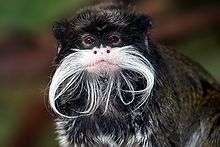Tamarin
This article includes a improve this article by introducing more precise citations. (November 2023) ) |
| Tamarins[1][2] | |
|---|---|

| |
| Emperor tamarin (Saguinus imperator) | |
| Scientific classification | |
| Domain: | Eukaryota |
| Kingdom: | Animalia |
| Phylum: | Chordata |
| Class: | Mammalia |
| Order: | Primates |
| Suborder: | Haplorhini |
| Infraorder: | Simiiformes |
| Family: | Callitrichidae |
| Genus: | Saguinus Hoffmannsegg, 1807 |
| Type species | |
Saguinus ursulus
, 1807 | |
| Species | |
|
22 species, see text | |
| Synonyms | |
| |
The tamarins are squirrel-sized New World monkeys from the family Callitrichidae in the genus Saguinus. They are the first offshoot in the Callitrichidae tree, and therefore are the sister group of a clade formed by the lion tamarins, Goeldi's monkeys and marmosets.[3]
Taxonomy and evolutionary history
Hershkovitz (1977) recognised ten species in the genus Saguinus, further divided into 33 morphotypes based on facial pelage.
Taxonomic classification
Following the taxonomic review of tamarins by Rylands et al. (2016) and Garbino & Martins-Junior (2018), there are 22 species in the genus Saguinus with 19 subspecies.[6][3][10]
- Genus Saguinus
- Subgenus Saguinus Hoffmannsegg, 1807
- S. midas group
- Saguinus midas
- Western black-handed tamarin or Saguinus niger
- Saguinus ursulus[11]
- S. bicolor group
- Saguinus bicolor
- Saguinus martinsi
- Martins's bare-face tamarin, Saguinus martinsi martinsi
- Ochraceus bare-face tamarin, Saguinus martinsi ochraceus
- S. oedipus group
- Saguinus oedipus
- Saguinus geoffroyi
- Saguinus leucopus
- S. midas group
- Subgenus Tamarinus Trouessart, 1904
- Saguinus mystax
- Spix's moustached tamarin, Saguinus mystax mystax
- Red-capped tamarin, Saguinus mystax pileatus
- White-rump moustached tamarin, Saguinus mystax pluto
- Saguinus labiatus
- Geoffroy's red-bellied tamarin, Saguinus labiatus labiatus
- Thomas's red-bellied tamarin, Saguinus labiatus thomasi
- Gray's red-bellied tamarin, Saguinus labiatus rufiventer
- Saguinus imperator
- Black-chinned emperor tamarin, Saguinus imperator imperator
- Bearded emperor tamarin, Saguinus imperator subgrisescens
- Saguinus inustus
- Subgenus Saguinus Hoffmannsegg, 1807
Description
Tamarin species vary considerably in appearance, ranging from nearly all black through mixtures of black, brown and white.
Distribution
Tamarins range from southern Central America through central South America, where they are found in northwestern Colombia, the Amazon basin, and the Guianas.[4]
Behavior and reproduction
This section needs additional citations for verification. (January 2024) |
Tamarins are inhabitants of
Tamarins are omnivores, eating fruits and other plant parts as well as spiders, insects, small vertebrates and bird eggs.
Cottontop tamarins (Saguinus oedipus) breed cooperatively in the wild. Cronin, Kurian, and Snowdon tested eight cottontop tamarins in a series of cooperative pulling experiments. Two monkeys were put on opposite sides of a transparent apparatus containing food. Only if both monkeys pulled a handle on their side of the apparatus towards themselves at the same time would food drop down for them to obtain. The results showed that tamarins pulled the handles at a lower rate when alone with the apparatus than when in the presence of a partner. Cronin, Kurian, and Snowdon concluded from this that cottontop tamarins have a good understanding of cooperation. They suggest that cottontop tamarins have developed cooperative behaviour as a cognitive adaptation.[15]
In some locations, saddle-back tamarins (subgenus Leontocebus) live
Predators
While tamarins spend much of their day foraging, they must be on high alert for aerial and terrestrial predators. Due to their small size compared to other primates, they are an easy target for predatory birds, snakes, and mammals.[16]
References
- OCLC 62265494.
- ISBN 978-0-387-78704-6.
- ^ PMID 28989098.
- ^ ISBN 9780226327884.
- PMID 1612537.
- ^ . Retrieved 19 April 2020.
- ^ "Leontocebus". Integrated Taxonomic Information System. Retrieved 19 April 2020.
- ^ "Leontocebus". ITIS. Retrieved 12 November 2021.
- ^ "Tamarinus". ITIS. Retrieved 2021-11-12.
- , retrieved 11 November 2021
- PMID 26120667.
- PMID 9210017.
- ISBN 978-3-510-61379-3.
- ^ Hakeem, A.; Sandoval, R.; Jones, M.; Allman, J. (1996). "Brain and life span in primates". In Birren, J. (ed.). Handbook of the Psychology of Aging. Academic Press. pp. 78–104.
- PMID 16804561.
- ISBN 978-0-521-01104-4.
External links
 Media related to Saguinus at Wikimedia Commons
Media related to Saguinus at Wikimedia Commons- Primate Info Net Saguinus Factsheets
